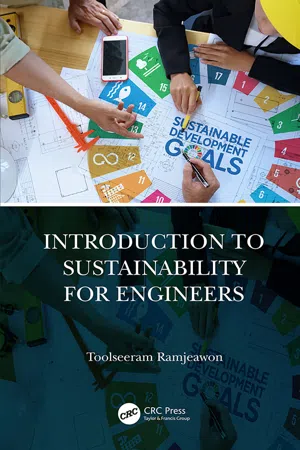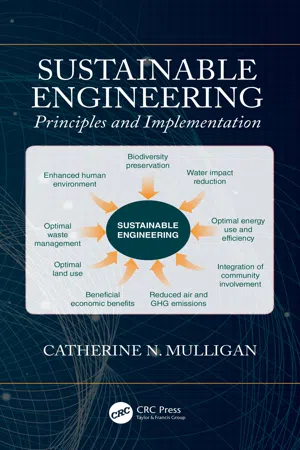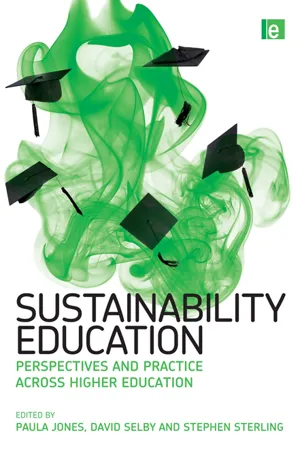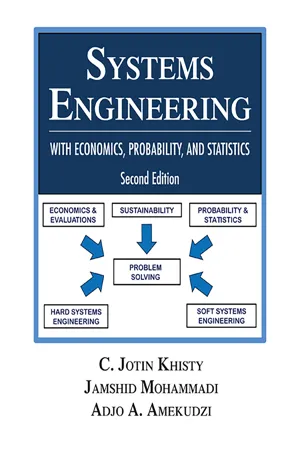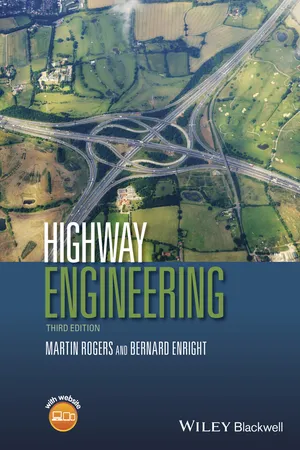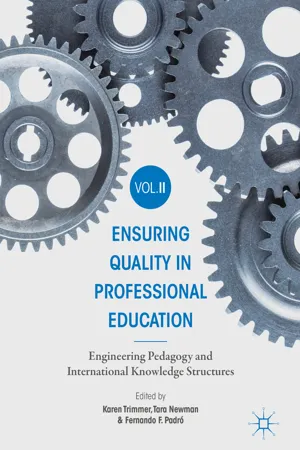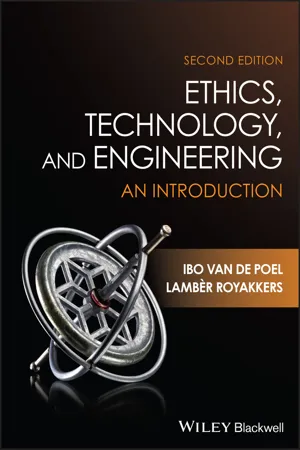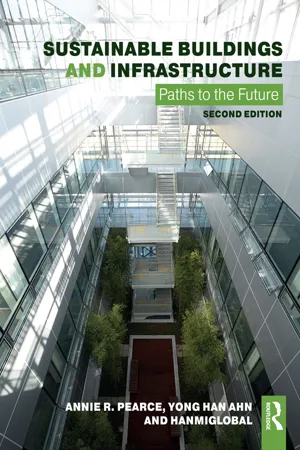Technology & Engineering
Sustainable Engineering
Sustainable engineering involves designing and implementing technological solutions that minimize negative environmental impacts, conserve resources, and promote long-term ecological balance. It focuses on creating innovative and efficient systems that meet present needs without compromising the ability of future generations to meet their own needs. This approach integrates environmental, social, and economic considerations to develop solutions that are environmentally responsible and resource-efficient.
Written by Perlego with AI-assistance
Related key terms
11 Key excerpts on "Sustainable Engineering"
- eBook - ePub
- Toolseeram Ramjeawon(Author)
- 2020(Publication Date)
- CRC Press(Publisher)
It is much more than the narrow discipline-specific activity of “protection of the environment” and engineers are required to take a wider perspective including goals such as poverty alleviation and social justice. There are a number of academic and professional institutions who have formulated Sustainable Engineering principles. The overarching goal is to generate a balanced solution to any engineering problem. If an engineering project benefits only one of the three sustainability dimension but ignores the others, it will be unsustainable in the long term. Some of the aspects that differentiate the traditional and sustainable approaches in engineering are given in Table 2.1. Table 2.1 Sustainability Approaches in Engineering Traditional Engineering Sustainable Engineering Considers the object or process Considers the whole system in which the object or process will be used Focuses on technical issues Considers both technical and nontechnical issues synergistically Solves the immediate problem Strives to solve the problem for infinite future Considers the local context Considers the global context Assumes others will deal with political, ethical, and societal issues Acknowledges the need to interact with the experts in other disciplines related to the problem Engineers understand the concept of physical principles such as conservation of mass, energy, or momentum. They provide the ideas, rules, or concepts to keep in mind when solving an engineering problem. Similarly, we need to be able to set our choices and engineering decisions against guiding principles for sustainability. The WFEO Model Code of Practice for Sustainable Development and Environmental Stewardship links the Code of Ethics with professional practice - eBook - ePub
Sustainable Engineering
Principles and Implementation
- Catherine Mulligan(Author)
- 2019(Publication Date)
- CRC Press(Publisher)
Procurement also needs to be included in sustainability. This includes no sweatshop labor or unfair labor practices or corruption, use of fair trade products, and support of local development. Engineers must improve sustainability of projects and processes for the future. Determination of indicators at an early stage of the project in consultation with stakeholders is essential. The engineer has the most influence in the early stage of the project. However, there are opportunities during commissioning, operation, and decommissioning to improve sustainability. Climate change is also causing more uncertainty in designs. New tools can help. Traditionally, projects have to meet the client and regulator’s requirements. The society is adding new requirements for the project in terms of sustainability. Engineers have an ethical requirement to face these new requirements. New tools are being developed to assist in the assessment but none is perfect. For example, LEED and BREEAM are restricted to buildings.Innovation is a key aspect for Sustainable Engineering. These projects are riskier and require more time initially. However, payoffs will be in the future with reduced operating costs. According to the World Federation of Engineering Organizations (WFEO 2015), engineers can contribute to sustainable practices in many ways. Some of these include harvesting renewable resources in ways to ensure continuous supply, minimization of nonrenewable resources, processing resources with little to no wastes, designing and building of infrastructure and processes with minimal waste and environmental impact throughout the life cycle, and development of clean renewable energy sources. Human needs must be met for ensuring adequate living and health standards. In other words, Sustainable Engineering involves the use of natural resources in a cost-effective way for the support of the human and natural environments. The approach should be as close to a closed loop as possible as proposed in the circular economy. In Chapter 5 - eBook - ePub
Life Cycle Assessment of Energy Systems
Closing the Ethical Loophole of Social Sustainability
- Nicholas Sakellariou(Author)
- 2018(Publication Date)
- Wiley-Scrivener(Publisher)
The design and social integration of engineered systems reflect normative, though not readily recognizable, assumptions and values; therefore, “development’s” effects on the social order are equivalent to any other form of political action; Engineering and science play a supportive, not central, role in the quest for sustainability; The logic of competitive productivism must be reconsidered. Provided that technology is autonomous, the urgent focus of sustainability engineering is reconceptualizing and redirecting democratic control of technical means and technical expertise.Throughout the 1990s, sustainability engineering was consistently discussed on the assumption of allegedly definable technological foundations.29 The technological change ideology of sustainability was the dominant influence in the sustainable development debate at least during the fourteen years from 1989 to 2003—a period I define here as the sustainable technology crisis. This position, advocated by the most vocal and powerful engineering constituencies, maintained that engineering and technology had created prosperity and improved the quality of life but that engineers, as Don Roberts put it, “unintentionally contributed to global environmental problems.”30 In celebrating innovation while defending the dominant business and economic culture of the 1990s US sustainability engineering leaders like Roberts and Hatch referenced the profession’s well-intentioned obliviousness, thus paving the way for the rise and legitimation of environmental metrics.31At least until 1998, most spokesmen of professional societies, engineering leaders in general, or codes of ethics in engineering argued that sustainable development signified environmentally sustainable development.32 “On a scale of one to ten, with one signifying ‘strictly development with modest modifications’ and ten signifying ‘strictly environmental protection,’ I am probably about a three,” said Hank Hatch in a 1992 interview.33 Engineering leaders, like Hatch or ASCE’s executive director, James E. Davis, embraced the oxymoronic predicament of “sustainable growth” which was, in fact, part and parcel of the professional discourse of sustainability in the late 1990s.34 - eBook - ePub
Sustainability Education
Perspectives and Practice across Higher Education
- Stephen Sterling(Author)
- 2010(Publication Date)
- Routledge(Publisher)
Chapter 10Engineering Our World Towards a Sustainable FutureEdited by Simon Steiner, with acknowledged contributionsIntroductionEngineers have the distinct advantage that, by virtue of their education and training, they are able to apply ingenuity and imagination to the rhetoric of others to create solutions for otherwise insoluble problems. It is this ability to take the ethos and words of others and to evolve realistic and working solutions that defines an engineer.The Engineering Council (EC), through its UK Standard for Professional Engineering Competence for the accreditation of higher education (HE) degree programmes, recognizes this expectation of graduate engineers towards achieving either their chartered or incorporated engineer status. The standard states that accredited programmes must demonstrate both general and specific learning outcomes, where the latter includes the economic, social and environmental context – in particular, ‘understanding of the requirement for engineering activities to promote sustainable development’ (EC, 2008, p13).In the past, there was little requirement for engineering graduates to consider social, economic and environmental issues. The embedding of sustainable development (SD) into the curriculum, however, now requires engineers to both understand and be able to work with knowledge of these contexts towards the solution of complex problems, particularly the kind of problems that they can expect to experience in their working lives as a professional engineer. This has been most recently recognized by the Engineering Council in promotion of its publication, Guidance on Sustainability (EC, 2009) to all professional engineers.This chapter draws together contributed case studies and discussion with the differing approaches that have been adopted by a number of UK university engineering faculties to embed SD into their taught curricula. It is organized into a number of sub-sections looking at learning approaches that engage engineering students with sustainability. Consideration is given to reaching out from engineering to design, to the environment and to international linkages between research and teaching. The overall aim is therefore for the transformation of student engineers into employable graduates who are articulate in their understanding of the issues and effective in their resolution of cross-disciplinary problems on the way to a world with a sustainable future. - eBook - ePub
- C. Jotin Khisty, Jamshid Mohammadi, Adjo Amekudzi(Authors)
- 2012(Publication Date)
- J. Ross Publishing(Publisher)
Engineering for sustainable development is, therefore, an ethical responsibility for civil engineers. Engineering for sustainable development can sometimes present ethical dilemmas requiring engineers to balance their responsibility for improving human welfare with their fidelity to clients who are their main sources of remuneration. Increasingly, engineers will be required to assume leadership roles to educate their clients and contractors about the benefits of Sustainable Engineering that may call for trading off short-term costs against long-term benefits. More and more engineering companies are demonstrating that they can take a leadership role in adapting to be more sustainable while simultaneously developing a competitive edge in their business, attracting clients who are willing to pay for higher quality products and services with fewer risks in the long run (Anderson, 1999). 14.1.3 Sustainability and Systems Thinking The principles of sustainability and systems thinking are closely linked. Taken together they contribute core values that form the basis for reshaping our planet. In contrast to the mechanistic Cartesian view of the world, the systems view emerging from general systems theory can be characterized as systemic, organic, holistic, complex, and ecological. In this sense the world is not seen as a machine made up of a multitude of parts, but is pictured as one indivisible, dynamic whole whose parts are essentially interrelated, interdependent, and can be understood only as patterns of a complex process. The principles of systems thinking are covered in Chapter 12, and readers are urged to go through it to more fully appreciate the topics dealt with in this chapter. Planners, engineers, and other professionals engage in sustainable development by using their skills and creativity for improving man-made and human-activity systems - eBook - ePub
- Martin Rogers, Bernard Enright(Authors)
- 2016(Publication Date)
- Wiley-Blackwell(Publisher)
Chapter 12 Defining Sustainability in Transportation Engineering12.1 Introduction
Sustainable development is development that meets the needs of the present without compromising the ability of future generations to meet their own needs (Brundtland Commission, 1987).More complex definitions recognise the need for true sustainability to balance the competing objects of society (social sustainability), the environment (environmental sustainability) and necessary economic objectives (economic sustainability), that is, people, the planet and profit, or equity, ecology and economics. Thus, in reality, we cannot achieve an ecological objective such as carbon neutrality without also having regard to the need to maintain a stable society and a growing and productive economy.12.2 Social sustainability
The challenge is to make people aware of the impact of our actions and decisions today on the generations of the future and to make people see the intrinsic worth of a more sustainable relationship with the planet and the resources within it. In many cases, maintaining and improving on what we already possess is more sustainable than developing something new from scratch.12.3 Environmental sustainability
For a transportation system to be environmentally sustainable, it needs to be ascertained that the receiving biological systems have the capacity to both process and digest any outputs it might produce. Any sustainable system must recognise these limits and work within them throughout its useful life. Designers must ensure that transport energy relies where possible on renewable resources and, where on-street capacity is restrained, more space-efficient methods of transportation such as public transport (PT) should be utilised. Designers must also strive to maximise the choice available to transport users. Cities offering a wide array of attractive transportation choices can quickly respond to changes in economic trends and to the effects of energy price spikes through minimising their dependency on one mode of transport. - eBook - ePub
Ensuring Quality in Professional Education Volume II
Engineering Pedagogy and International Knowledge Structures
- Karen Trimmer, Tara Newman, Fernando F. Padró, Karen Trimmer, Tara Newman, Fernando F. Padró(Authors)
- 2019(Publication Date)
- Palgrave Macmillan(Publisher)
The main promise upon which SEng hopes to base itself into the future, so long as it is not reversed by a future right wing led US government, would be the recent ‘2015 Paris Agreement’. Conducted under the auspices of the United Nations Framework Convention on Climate Change (UNFCCC), this pivotal piece of legislation now strengthens the sentiments of the Kyoto 1997 Agreement. It for the first time firmly quotes target of +2 °C, as the maximum permitted global warming above pre-industrial levels. Presented by the 21st Conference of the Parties (COP21) in Paris on 12 December 2015, the ‘language of the agreement’ was endorsed by 195 countries and was actually ratified by 15. Unfortunately, the 2 °C target has some way to go until it comes into legal force across the globe.Method
At the University of Southern Queensland (USQ) approximately ten years ago, new material on Sustainable Engineering (SEng) was introduced into an existing course entitled ‘Technology and Society’. Three years ago, it was decided to rename the course to ‘ENG2002 Technology, Sustainability and Society’ and restructure the course as follows:-- Module 1—Introduction
- Module 2—History of technology
- Module 3—Sustainability
- Module 4—Environmental impact assessment
- Module 5—Politics and power
- Module 6—The economy
- Module 7—Models of society
- Module 8—Cultural impacts
- Module 9—The legal framework
- Module 10—Management concepts in SEng
Thus, SEng is placed within economic and social contexts, with the course objectives are described as follows:- 1. Converse proficiently upon general knowledge and current affairs of the day
- 2. Appreciate the history of technology, assess the basis of common criticisms of modern technology, and associated benefits to human society
- 3. Understand the basic concepts behind environmental sustainability and justify the need to move towards more sustainable practices
- 4. Understand the concepts behind and be able to apply the principles of effective environmental impact assessment
- 5. Understand the role of politics, politicians, power and government and illustrate the political dimension of engineering and surveying activities
- 6. Acquire a basic knowledge of economics and profitability forecasting, be able to perform a simple Net Present Value (NPV) exercise using Excel spreadsheet, and assess the likely effects of economic policies on technological enterprises
- 7. Appreciate the relevance of social structures and cultural values and deduce the causal factors behind technological developments during different periods of human history
- eBook - ePub
Ethics, Technology, and Engineering
An Introduction
- Ibo van de Poel, Lamber Royakkers(Authors)
- 2023(Publication Date)
- Wiley-Blackwell(Publisher)
Chapter 2 ), for example, states that “Engineers are encouraged to adhere to the principles of sustainable development in order to protect the environment for future generations,” and the Code of Conduct of ENGINEERS EUROPE states that “Engineers shall carry out their tasks so as to prevent … avoidable adverse impact on the environment.” These broadly formulated responsibilities also imply that engineers have a responsibility to design technological products for sustainability.8.3 Sustainable Development
8.3.1 The Brundtland definition
Nowadays, sustainability is often conceived as the result of a societal and economic process of development, and that is why discussions about sustainability are often conducted in terms of sustainable development. The best-known and most influential definition of sustainable development originates from the Brundtland report:Sustainable development is development that meets the needs of the present without compromising the ability of future generations to meet their own needs. It contains within it two key concepts:Sustainable development Development that meets the needs of the present without compromising the ability of future generations to meet their own needs (Brundtland definition).- the concept of ‘needs,’ in particular the essential needs of the world’s poor, to which over-riding priority should be given; and
- the idea of limitations imposed by the state of technology and social organization on the environment’s ability to meet present and future needs. (World Commission on Environment and Development, 1987)
The Brundtland Commission or the World Commission on Environment and Development (WCED) proposed the concept of sustainable development as an ideal for the global economy and corporations. Sustainable development is the foundation for today’s leading global framework for international cooperation: the 2030 Agenda for Sustainable Development and its Sustainable Development Goals (SDGs) (see also Subsection 2.2.2). The SDGs form the framework for improving the lives of populations around the world and mitigating the hazardous man-made effects of environmental problems: - eBook - ePub
Lees' Process Safety Essentials
Hazard Identification, Assessment and Control
- Sam Mannan(Author)
- 2013(Publication Date)
- Butterworth-Heinemann(Publisher)
1. Abraham, M.A., 2004. Sustainable Engineering: An initiative for chemical engineers. Environmental Progress. 23 (4), 261–263.2. Anastas PT, Warner JC. Green Chemistry: Theory and Practice New York, NY: Oxford University Press; 1998.3. Anastas PT, Zimmerman JB. The twelve principles of green engineering as a foundation for sustainability. In: Abraham MA, ed. Sustainability Science and Engineering Defining Principles . Elsevier 2006.4. AIChE (American Institute of Chemical Engineers). Total Cost Assessment Methodology Manual New York, NY: AIChE Center for Waste Reduction Technology, Institute for Sustainability; 2000.5. Azapagic A. Life cycle assessment and its application to process selection, design and optimisation. Chem Eng J. 1999;73:21.6. Azapagic A, Perdan S, Clift R. Sustainable Development in Practice: Case Studies for Engineers and Scientists John Wiley & Sons 2004.7. Barrios E, Komoto K. Some approaches in the construction of a sustainable development index for the Philippines. Int J Sustain Develop World Ecol. 2006;13:277–288.8. Beloff B, Lines M, Tanzil D. Transforming Sustainability Strategy into Action Hoboken, NJ: Wiley; 2005.9. Böhringer C, Jochem PEP. Measuring the immeasurable: a survey of sustainability indices. Ecol Econ. 2007;63(1):1.10. Brundtland GH. For World Commission on Environment and Development—Our Common Future Oxford: Oxford University Press; 1987.11. Carson R. Silent Spring Boston, MA: Houghton Mifflin; 1962.12. Cobb CW. The index for sustainable economic welfare. In: Daly H, Cobb JB, eds. For the Common Good-Redirecting the Economy Toward Community, the Environment, and a Sustainable Future . Boston, MA: Beacon Press; 1989;401–457.13. Cobb CW, Halstead T, Rowe J. The Genuine Progress Indicator: Summary of Data and Methodology Washington, DC: Redefining Progress; 1995.14. Custance J, Hiller H. Statistical issues in developing indicators of sustainable development. J R Stat Soc A . 1998;161(3):281–290.15. Database IVAM LCA Data 4.04. European Commission - DG Joint Research Centre – Institute for Environment and Sustainability, 2010. <http://lca.jrc.ec.europa.eu/lcainfohub/database2.vm?dbid=126 - J. K. Yates, Daniel Castro-Lacouture(Authors)
- 2018(Publication Date)
- CRC Press(Publisher)
4 Sustainable Engineering Design4.1 INTRODUCTION
According to the article “Environmental Process Engineering: Building Capacity for Sustainability” (Libra 2007, p. 312), 60%–80% “of the overall product costs, as well as a product’s environmental impact are determined during the design phase”; therefore, this chapter introduces some of the design considerations affecting the sustainability of projects. This chapter includes information on the types of sustainable elements available for incorporation into designs. Designing for passive survivability is explained along with the similarity between passive survivability and sustainable designs. The criteria for sustainable site selection are discussed and so are the options of selecting green-, gray-, or brownfield sites. The requirements for sustainable landscapes are explained, and the processes required for designing storm water management systems are also introduced in this chapter. Methods for evaluating sustainable process alternatives are mentioned, as well as procedures for designing for the use of sustainable materials. One major element of design is ensuring that designs incorporate the principles and strategies of designing for disassembly, and suggestions are outlined in this chapter for this process. The International Organization for Standardization- eBook - ePub
Sustainable Buildings and Infrastructure
Paths to the Future
- Annie R. Pearce, Yong Han Ahn, Ltd HanmiGlobal Co(Authors)
- 2017(Publication Date)
- Routledge(Publisher)
Sustainable facilities and infrastructure systems require fewer resources to meet the needs of their users, thus reducing the costs over time to operate and maintain these facilities. The array of new technologies that is evolving to improve the sustainability of the built environment creates jobs and establishes new markets. For example, new technologies for renewable energy have resulted in the growth of new manufacturing enterprises and supply chains to produce these technologies. New jobs are also created for people who install and maintain these systems, and new educational programmes and degrees are needed to train these new workers in the green economy. New business models such as long-term product leases have also been developed as an alternative to conventional purchase of building technologies, resulting in the need for new businesses who manage the leasing and upgrade process. All of these changes in construction technology help to stimulate the economy and provide new opportunities to replace and enhance the inefficient and unsustainable industries of the past. Finally, sustainable design and construction tactics can result in significant social benefits to both facility stakeholders and society at large in addition to their environmental and economic benefits. In the building sector, sustainable facilities have been observed to enhance occupant comfort, health and productivity. For example, daylighting in green buildings has been correlated with reduced absenteeism among employees in general, increased productivity among factory workers and improved test scores, growth rates and dental health in schoolchildren (EPA 2016b). The use of sustainable technologies and practices creates new employment opportunities that can stimulate local economies and help to stabilize communities, especially those that are suffering from loss of jobs as a result of industry downsizing and outmoded technologies
Index pages curate the most relevant extracts from our library of academic textbooks. They’ve been created using an in-house natural language model (NLM), each adding context and meaning to key research topics.
